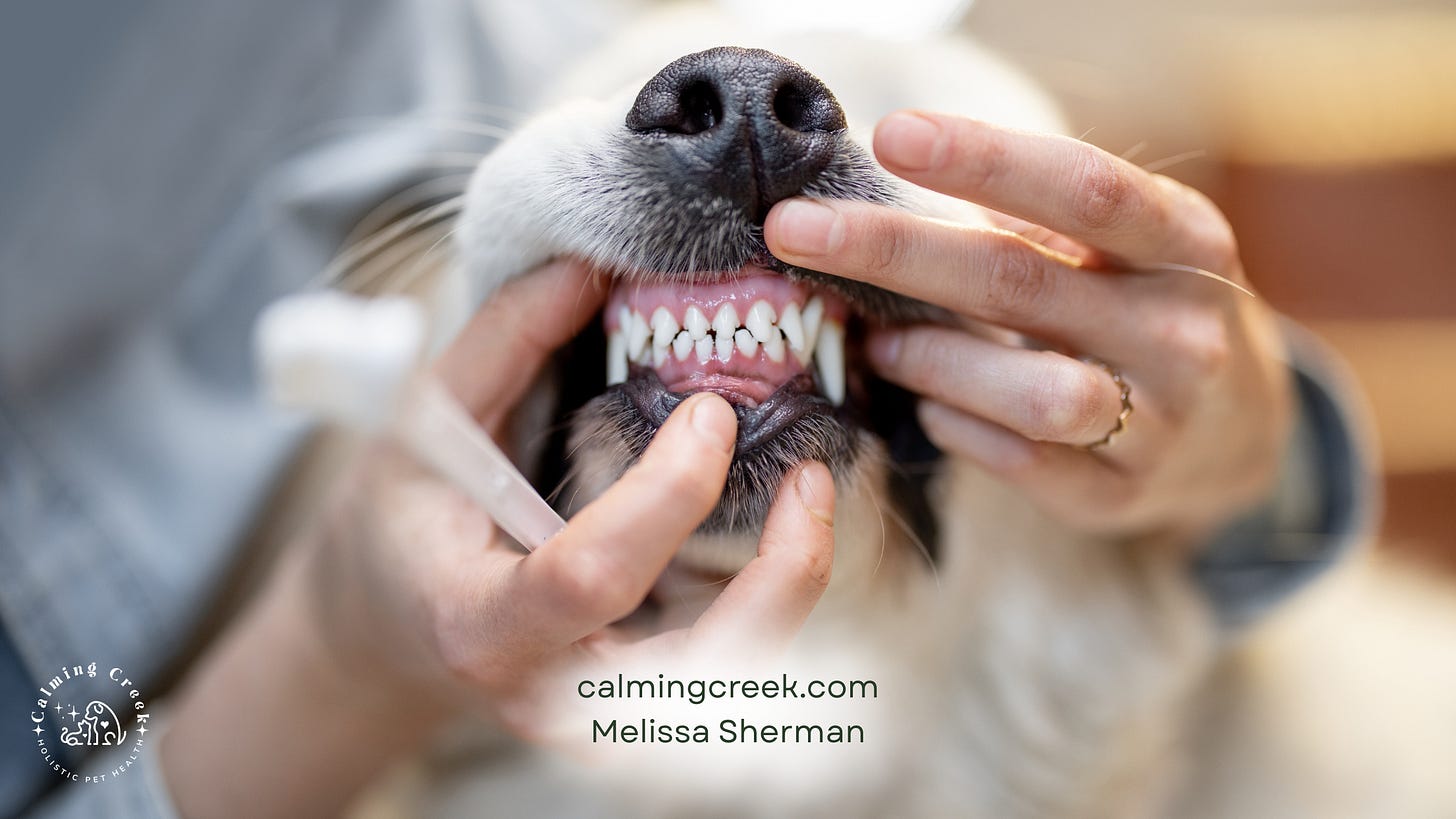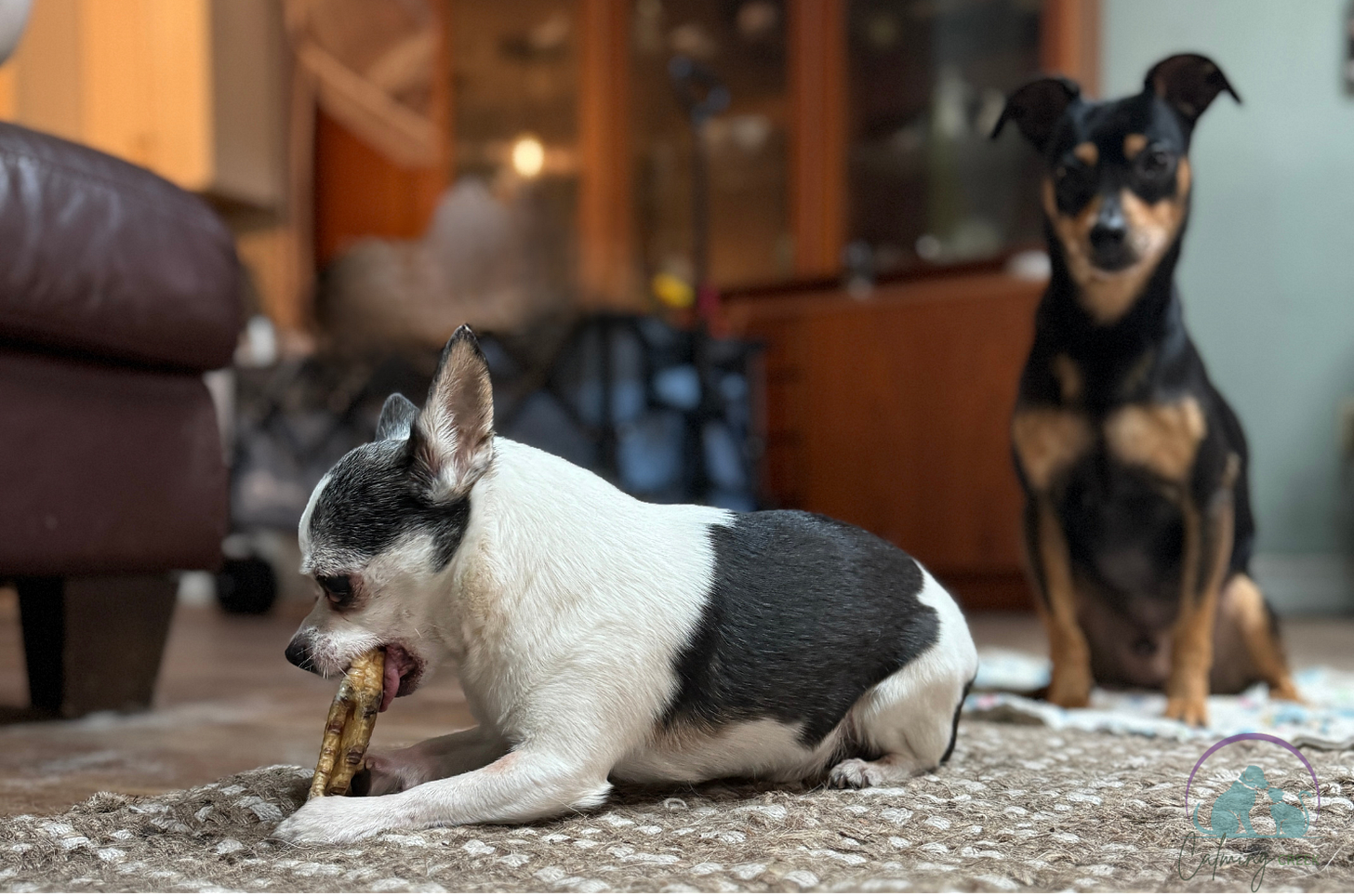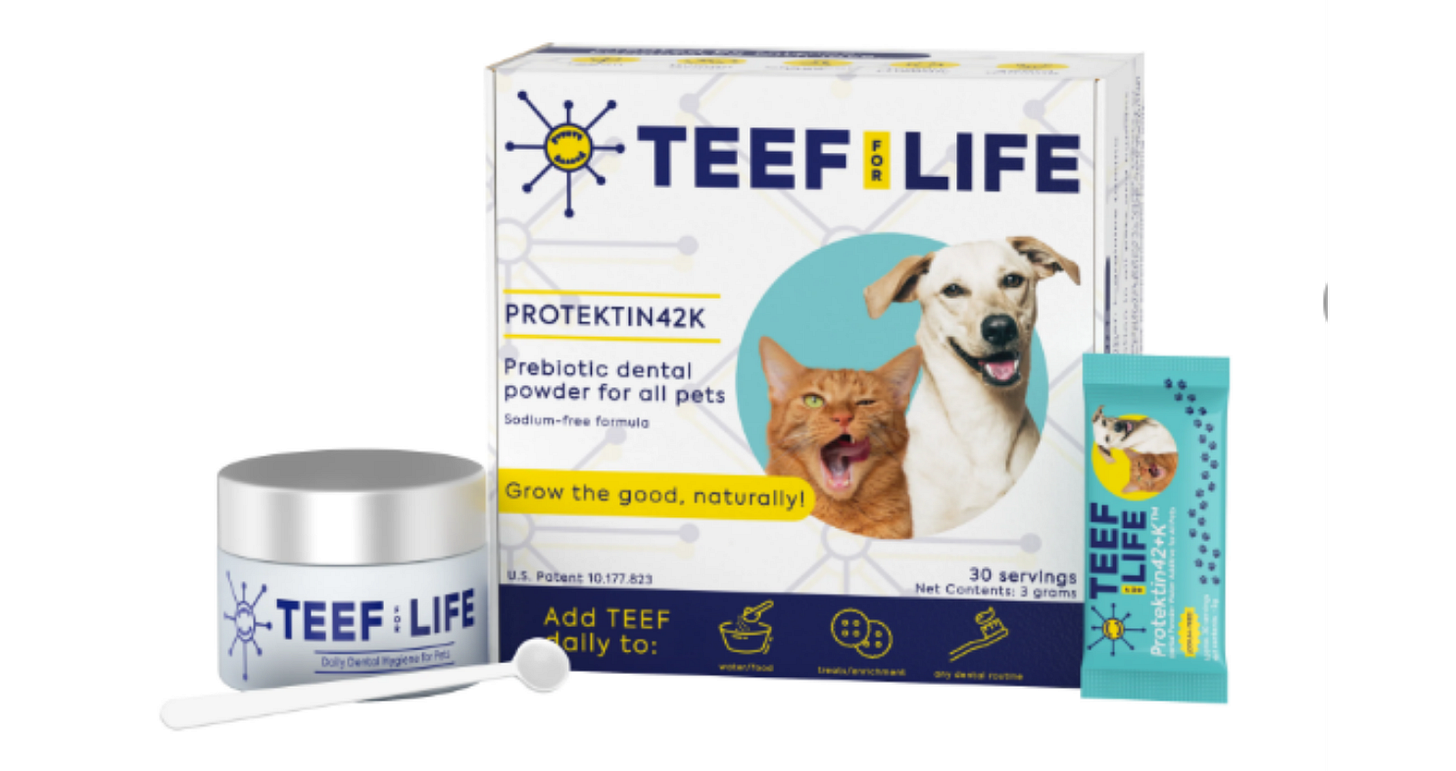How I Cared for My Dog’s Teeth Naturally When Anesthesia Wasn’t an Option
Natural Dog Dental Care and Gum Disease Remedies Without Anesthesia
By Melissa | Animal Intuitive, Energy Healer & Holistic Pet Health Coach
Gum disease in dogs is more than just bad breath. It can impact your dog’s overall health, affecting the heart, kidneys, and immune system. Early, natural care helps prevent pain, costly treatments, and can even extend your dog’s life.
As a holistic animal practitioner and pet parent, I know firsthand how powerful a gentle, natural approach can be. My dog Cooper, a senior Chihuahua, almost lost his life during what was supposed to be a routine dental cleaning at age four. He stopped breathing on the table and was thankfully revived, but that moment cemented my worst fears. After that terrifying experience, I found myself in a real dilemma, not knowing how to care for his dental health safely since anesthesia was no longer an option. I also knew that small breeds like Chihuahuas are especially prone to dental issues, which made the situation feel even more overwhelming.
Let me walk you through my experience and the practical, holistic methods that worked for us. If Cooper and I can manage his oral health naturally and keep all his teeth at 13 years old, so can you!
Understanding Gum Disease and Why It Matters
Gum disease, or periodontal disease, starts with plaque and tartar buildup that inflames gums and damages the tissues supporting teeth. Early signs include bad breath, red or swollen gums, and occasional bleeding while chewing. Left untreated, gum disease can lead to pain, infections, tooth loss, and impact vital organs.
The process begins with gingivitis, which is reversible if addressed early. Without care, it progresses to periodontitis—damage to gums and bone that causes lasting problems and pain.
The bacteria causing gum disease can enter the bloodstream and affect organs like the heart and kidneys. That’s why oral health is about more than just teeth, it’s about your dog’s whole-body wellness.
Proactive Daily Oral Care for Your Dog
Prevention is key. Starting with daily oral care can help avoid problems before they start.
Brushing Made Easier
Brushing is still one of the most effective ways to prevent plaque. Use a dog-specific toothbrush and toothpaste (or make your own with coconut oil and baking soda). Many dogs dislike brushes, so I’ve found a great alternative:
DIY Herbal Oral Rinse
1 cup distilled water
1 tsp dried chamomile
1 tsp dried calendula
1 tsp aloe vera juice (optional)
Steep chamomile and calendula in boiling water for 10 minutes, strain, and let cool. Use a clean gauze soaked in this rinse to gently wipe your dog’s teeth and gums. I find many dogs prefer this over a brush or finger brush. It feels soothing and less invasive.
Bones, Dental Chews, and Natural Toys
Chewing is one of the most natural and effective ways dogs clean their own teeth. Providing safe, engaging dental toys or chews not only supports oral health but also offers enrichment.
One of the best choices I made for Cooper early on was incorporating meaty bones and natural chews. Since anesthesia was no longer an option for him, I relied heavily on daily chewing to support his dental health. Under supervision, Cooper chews on raw chicken wings, turkey necks, and dehydrated duck or chicken feet. The natural act of tearing meat and ligaments from the bone provides a brushing-like effect that helps keep his teeth clean and his gums stimulated.
Natural Dental Treat: DIY Dehydrated Duck or Chicken Feet
These crunchy treats are easy to make, rich in joint-supportive nutrients like collagen, and a fantastic way to naturally clean your dog’s teeth.
What You’ll Need:
Raw chicken feet or duck feet (cleaned, with nails trimmed if desired)
A dehydrator (or oven with a low-temp setting)
Instructions:
Rinse the feet thoroughly and pat them dry.
Arrange them in a single layer on dehydrator trays or a parchment-lined baking sheet.
Dehydrate at 160–170°F (or use the “meat” setting) for 24–36 hours until fully dried and crispy.
Cool completely and store in an airtight container. Refrigeration helps extend shelf life.
Pro Tip: Always supervise when offering new chews. Feed 1–2 times per week depending on your dog’s size, jaw strength, and chewing behavior.
These are a favorite in our household—Cooper still gets excited every time I bring one out!
Diet Matters (More Than You Think)
Your dog’s diet plays a major role in their dental and overall health. A fresh, whole food diet, whether raw or gently cooked, can help support the natural oral microbiome, reduce inflammation, and strengthen your dog’s immune system. It also promotes healthier gums and reduces tartar buildup.
In contrast, kibble is often high in refined carbohydrates and starches, which can stick to your dog’s teeth and feed the harmful bacteria that contribute to plaque and gum disease. Many pet parents are surprised to learn that dry kibble doesn’t “clean” teeth, despite what the marketing says. In fact, kibble may do the opposite by creating a film of sugars that adheres to teeth and leads to decay over time.
Switching to fresh food was one of the best decisions I made for Cooper. His gums looked better, his breath improved, and it supported his entire system, not just his smile.
If you're not ready to go fully fresh, even adding in fresh toppers like raw meaty bones, crunchy vegetables, or lightly cooked proteins can make a noticeable difference. Your dog’s mouth (and body) will thank you.
Supplements and Products I Trust
On Kelp-Based Powders
I’ve tried several kelp-based dental powders over the years. While some helped reduce plaque, I’ve started limiting kelp because many ocean-sourced kelp products test high for heavy metals like arsenic and mercury due to pollution concerns. It’s important to source supplements carefully and avoid overdoing anything.
Why I Use Teef
One product I consistently use for my dogs and cats is Teef, a natural dental powder designed to support the oral microbiome and reduce harmful bacteria. It’s easy to add to water bowls or food and has made a noticeable difference in freshening breath and supporting gum health.
If you want to learn more about Teef, here’s their website: Teef Health
Understanding Homeopathy for Dog Dental Care
Homeopathy uses highly diluted remedies to stimulate the body’s natural healing. It’s gentle and individualized, making it useful for acute issues like pain, abscesses, or post-extraction care.
Some common remedies for dental issues include:
Hepar Sulphuris: For painful abscesses or sensitivity to cold or touch
Silicea: Supports healing and helps expel infection, great for recurring inflammation
Mercurius Solubilis: Used when there’s bleeding, drooling, or foul breath
Homeopathy can be a valuable part of your dog’s routine dental care but should be used under the guidance of an experienced veterinarian or homeopathic practitioner. They can help select the right remedy and dosage for your dog’s specific needs.
When to Seek Veterinary Care
Natural care is powerful, but there are times when professional intervention is needed. Contact your vet immediately if you notice:
Loose or missing teeth
Refusal to eat or chew
Excessive drooling or bleeding
Visible swelling or pus in the mouth
Signs of pain or aggression when the mouth is touched
Modern anesthesia is much safer than before, but if your dog can’t have anesthesia like Cooper, there are still many supportive at-home steps you can take.
Start Small, See Big Results
Managing your dog’s oral health naturally might feel overwhelming at first, but with patience and consistent care, it becomes second nature. You’re already doing an amazing job just by learning and trying—keep going!
By combining daily care, mindful diet, trusted supplements, and homeopathic support, you can help your dog keep a healthy, comfortable smile well into their senior years.
Thank you so much for reading this post ! Please let me know what you think about the post.
My name is Melissa, and I’m an animal communicator, energy healer, and holistic pet health coach. I weave together a variety of gentle, natural modalities to support animals and their humans including Reiki, EFT/Tapping, chakra balancing, muscle testing, tuning fork fascia release, canine herbalism, and both feline and canine nutrition. I'm also currently studying clinical animal iridology to further expand the holistic lens I bring to this work.
I live on a little farm sanctuary where I'm happily outnumbered by animals—seven dogs, three cats, and a mix of other furry, feathered, and hooved friends who keep life interesting. My approach is heart-centered and intuitive, combining ancient practices and modern knowledge to help bring balance, comfort, and clarity to our four-legged companions.
Thank you for taking the time to explore ways to enhance the quality of life for your furry companions. I hope my tips and recommendations prove invaluable to both you and your beloved pets. For more information and to discover how I can assist you further, please visit my website at calmingcreek.com.
I'd love to hear from you! Whether you have stories to share or questions to ask, don't hesitate to join the conversation in the comments section below.
For more pet health tips and other ways to connect:
Disclaimer: The information shared in this blog is for educational and informational purposes only. I am not a veterinarian, and my services are intended as a complementary practice to support your pet’s overall well-being. They are not a substitute for professional veterinary care, diagnosis, or treatment. Always consult your veterinarian regarding any medical concerns, conditions, or treatments your pet may require.
Affiliate Disclosure: Some of the links on this website are affiliate links, meaning, at no additional cost to you, I may earn a commission if you click through and make a purchase. This helps support my work in creating content for this site. I only recommend products or services that I personally use and believe will add value to my readers.




